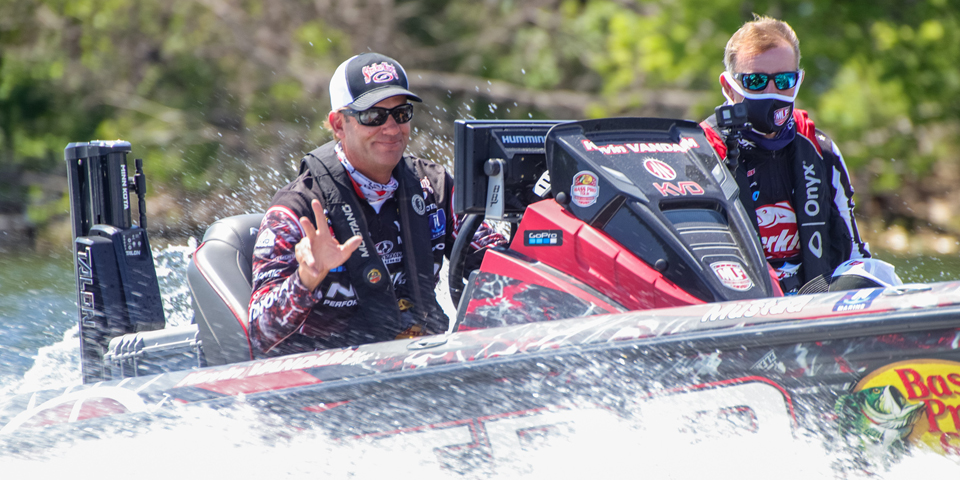KEVIN VANDAM: Affordable Fishing Tech Has Come a Long Way

There’s little doubt that the evolution of fishing technology has ramped up tremendously over the last decade. Having been in this sport now for some 30 years, sometimes I look at our current technological advancements and wonder how in the world we ever fished without them.
Some of the younger anglers coming up through the high school and college ranks might not know what a LORAN unit is, or a paper graph, or even a paper map for that matter. Occasionally, I like to look back (zoom out so to speak) and see just how far we’ve come in fish-finding efficiency. These products don’t just help professional bass anglers, they also help thousands of weekend anglers make better use of their fishing time and catch more fish.
I know we always hear about the “good old days” in bass fishing when fishing “used to be so good.” However, I contend that today’s hobbyist-level bass anglers catch more bass these days than the same level angler did 30 years ago, thanks in large part to the vast advancements in technology.
Over the next couple of blogs, I want to retrace the footsteps of some of this technology to give folks an idea of just how far it’s come. These will be in no particular order simply because they’ve all been critical advancements to the sport. It’s hard to point to any single one and say: this is the most important improvement because they all have their shining moments throughout any given tour season.
The GPS Journey
While my career does extend back far enough to include visual cross-triangulation – using objects on land to stay on a fishing spot – my first ever electronic positioning unit was a LORAN chart plotter that worked off of land-based towers sending radio signals to plot your position. These units could get you to within a couple hundred feet of a marked spot – nowhere close the accuracy we have today.
But trust me, to be able to return to the same general area with reliability on a lake like Erie or Okeechobee was huge. Otherwise, if you were way offshore and had very limited landmarks, you were lucky to get within a half-mile of where you intended to be.
From there, GPS technology came about and made things much better in terms of positioning. The first GPS chart plotters were slow but more accurate than LORAN, getting down to 50 to 100 feet of where you wanted to be. Compared to modern-day units, early GPS still left a lot of blanks to be filled in, mostly because of mapping.
The Dawn of Digital Mapping
Today, most anglers view GPS positioning and digital mapping as one and the same, but they are two different things. When GPS units first came out, it put your location on a “basemap,” which was basically a rough sketch of the lake with no contours of any type. You could only discern land (yellow) from water (blue). You could mark waypoints and return to them and it was certainly a big help in navigating unfamiliar twisty-turvy lakes like Lake of the Ozarks. But when looking for fish offshore, you still had to use a paper contour map at all times to find points, humps, shoals, ledges and ditches.
It wasn’t until companies started putting digital contour maps on SD cards to be used on GPS chart plotters that the offshore game really ignited. Chart plotters evolved, GPS got far more accurate and mapping definition got extreme. The detail found in today’s LakeMaster mapping is something I never thought I would see in my lifetime: it’s like seeing the lake bottom when it’s drained! Add to that the precision of today’s GPS units and you have the ability to drive straight to any bottom structure you want to fish.
Even if there is not a mapping card available for the lakes or areas you like to fish, today’s electronics have the incredible ability to actually map areas for you and to create your own custom topo map of your fishery. Whether you use a mapping card or create your own map, you can also customize your own contour colors and shading to fit how you want to see different depth zones.
Most people think you have to drop a couple of grand to add these GPS and mapping advancements to your fishing arsenal – that’s simply not true. These features are readily available at nominal price points. When I look back at what we used to have for positioning and mapping and look at what’s available now, it’s amazing how far it has all come. Now, to put 30 years of innovation and advancement into an affordable unit that the weekend angler can put on his boat is a win-win for all.
In the next edition, I’ll trace back sonar, trolling motors and shallow water anchors to see just how much ground the sport covered with those fishing tools.